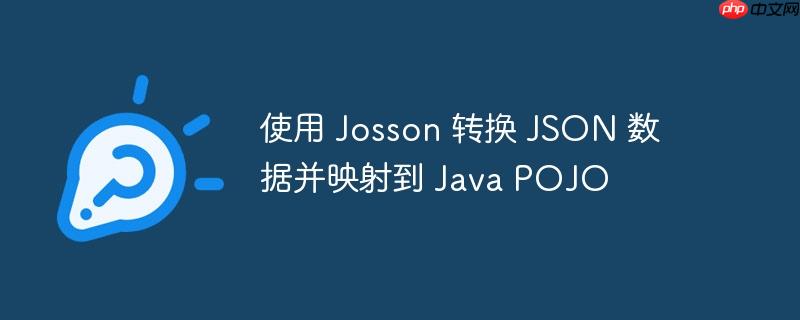
本文将介绍如何使用 Josson 库将复杂的 JSON 结构转换为 Java POJO (Plain Old Java Object),并计算每个单词在数组中的最小和最大出现次数。通过 Josson 提供的强大 JSON 查询和转换功能,可以简化数据处理过程,提高开发效率。
在处理 JSON 数据时,我们经常需要将 JSON 数据映射到 Java 对象。对于简单的 JSON 结构,可以使用 Jackson 等库直接进行反序列化。但是,对于复杂的 JSON 结构,例如需要对数据进行聚合、转换等操作,直接使用 Jackson 可能会比较繁琐。本文将介绍如何使用 Josson 库来简化这个过程。
Josson 是一个强大的 JSON 处理库,它提供了类似于 SQL 的查询语法,可以方便地对 JSON 数据进行过滤、转换、聚合等操作。我们可以使用 Josson 将复杂的 JSON 结构转换为我们需要的格式,然后再使用 Jackson 将其反序列化为 Java 对象。
1. 定义 Java POJO
立即学习“Java免费学习笔记(深入)”;
首先,我们需要定义一个 Java POJO 来存储转换后的数据。在本例中,我们需要存储每个单词的文本、最小出现次数和最大出现次数。
public class Word {
private String text;
private Integer min;
private Integer max;
public void setText(String text) {
this.text = text;
}
public void setMin(Integer min) {
this.min = min;
}
public void setMax(Integer max) {
this.max = max;
}
@Override
public String toString() {
return String.format("text=%s min=%d max=%d", text, min, max);
}
}2. 使用 Josson 转换 JSON 数据
接下来,我们需要使用 Josson 将 JSON 数据转换为我们需要的格式。在本例中,我们需要将 JSON 数据转换为一个包含 text、min 和 max 字段的 JSON 数组。
Josson josson = Josson.fromJsonString(
"[" +
" [" +
" {\"word\": \"china\", \"count\": 0}," +
" {\"word\": \"kids\", \"count\": 1}," +
" {\"word\": \"music\", \"count\": 0}" +
" ]," +
" [" +
" {\"word\": \"china\", \"count\": 3}," +
" {\"word\": \"kids\", \"count\": 0}," +
" {\"word\": \"music\", \"count\": 2}" +
" ]," +
" [" +
" {\"word\": \"china\", \"count\": 10}," +
" {\"word\": \"kids\", \"count\": 3}," +
" {\"word\": \"music\", \"count\": 2}" +
" ]" +
"]");
JsonNode node = josson.getNode(
"flatten()" +
".group(word)" +
".map(text:word, min:elements.min(count), max:elements.max(count))");这段代码首先使用 Josson.fromJsonString() 方法将 JSON 字符串转换为 Josson 对象。然后,使用 josson.getNode() 方法执行以下操作:
3. 使用 Jackson 反序列化 JSON 数据
最后,我们需要使用 Jackson 将转换后的 JSON 数据反序列化为 Java 对象。
List<Word> words = new ObjectMapper().convertValue(node, new TypeReference<List<Word>>() {});
words.forEach(System.out::println);这段代码使用 ObjectMapper.convertValue() 方法将 Josson 生成的 JsonNode 对象转换为 List
4. 完整示例代码
import com.fasterxml.jackson.core.type.TypeReference;
import com.fasterxml.jackson.databind.JsonNode;
import com.fasterxml.jackson.databind.ObjectMapper;
import org.octomix.josson.Josson;
import java.io.IOException;
import java.util.List;
public class JossonExample {
public static void main(String[] args) throws IOException {
Josson josson = Josson.fromJsonString(
"[" +
" [" +
" {\"word\": \"china\", \"count\": 0}," +
" {\"word\": \"kids\", \"count\": 1}," +
" {\"word\": \"music\", \"count\": 0}" +
" ]," +
" [" +
" {\"word\": \"china\", \"count\": 3}," +
" {\"word\": \"kids\", \"count\": 0}," +
" {\"word\": \"music\", \"count\": 2}" +
" ]," +
" [" +
" {\"word\": \"china\", \"count\": 10}," +
" {\"word\": \"kids\", \"count\": 3}," +
" {\"word\": \"music\", \"count\": 2}" +
" ]" +
"]");
JsonNode node = josson.getNode(
"flatten()" +
".group(word)" +
".map(text:word, min:elements.min(count), max:elements.max(count))");
List<Word> words = new ObjectMapper().convertValue(node, new TypeReference<List<Word>>() {});
words.forEach(System.out::println);
}
}5. 运行结果
运行上述代码,将得到以下输出:
text=china min=0 max=10 text=kids min=0 max=3 text=music min=0 max=2
本文介绍了如何使用 Josson 库将复杂的 JSON 结构转换为 Java POJO。通过 Josson 提供的强大 JSON 查询和转换功能,可以简化数据处理过程,提高开发效率。Josson 的语法简洁易懂,可以快速上手。在处理复杂的 JSON 数据时,可以考虑使用 Josson 来简化开发。
注意事项:
通过本文的介绍,相信读者已经掌握了使用 Josson 转换 JSON 数据并映射到 Java POJO 的方法。希望本文能够帮助读者在实际开发中更好地处理 JSON 数据。
以上就是使用 Josson 转换 JSON 数据并映射到 Java POJO的详细内容,更多请关注php中文网其它相关文章!

每个人都需要一台速度更快、更稳定的 PC。随着时间的推移,垃圾文件、旧注册表数据和不必要的后台进程会占用资源并降低性能。幸运的是,许多工具可以让 Windows 保持平稳运行。

Copyright 2014-2025 //m.sbmmt.com/ All Rights Reserved | php.cn | 湘ICP备2023035733号